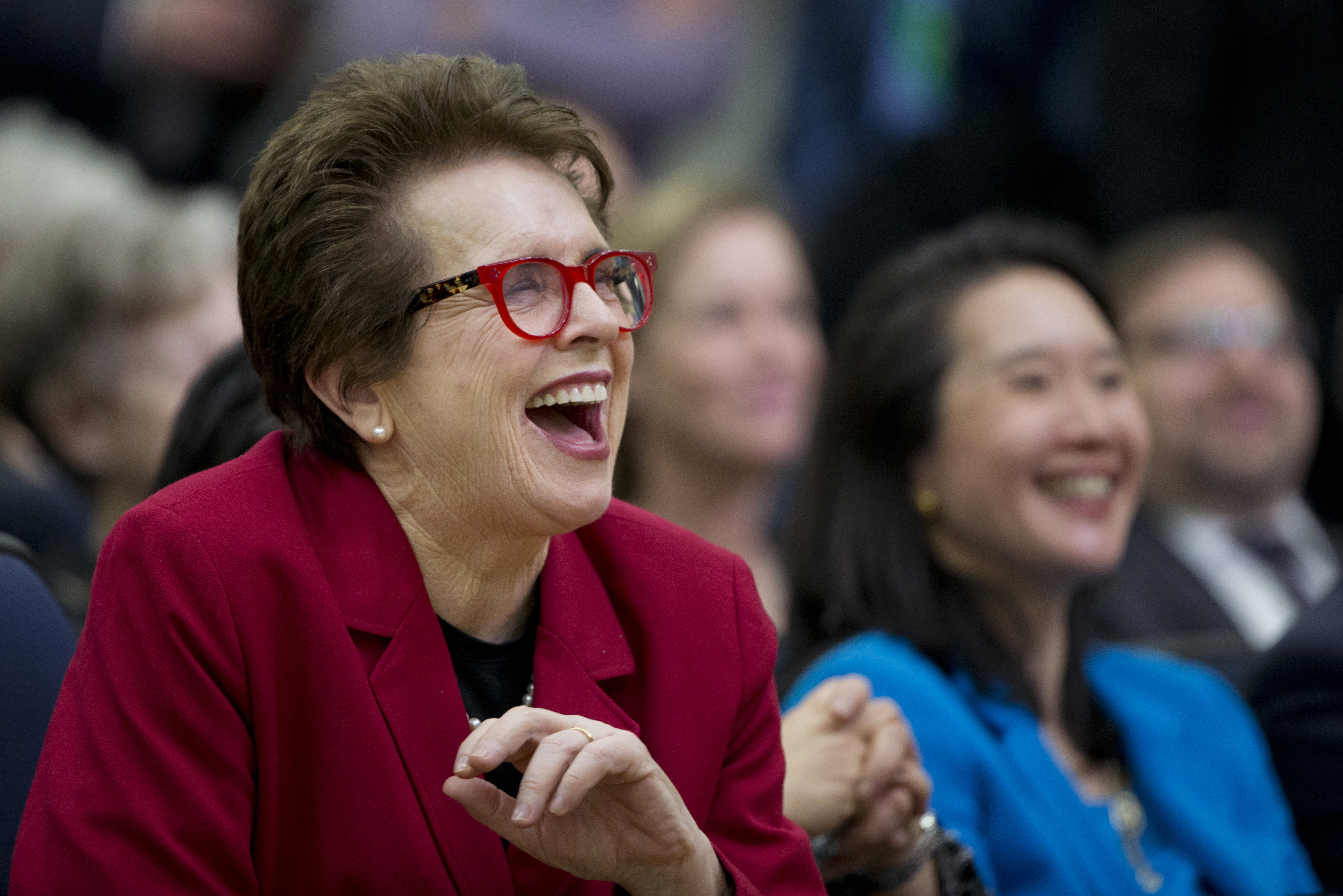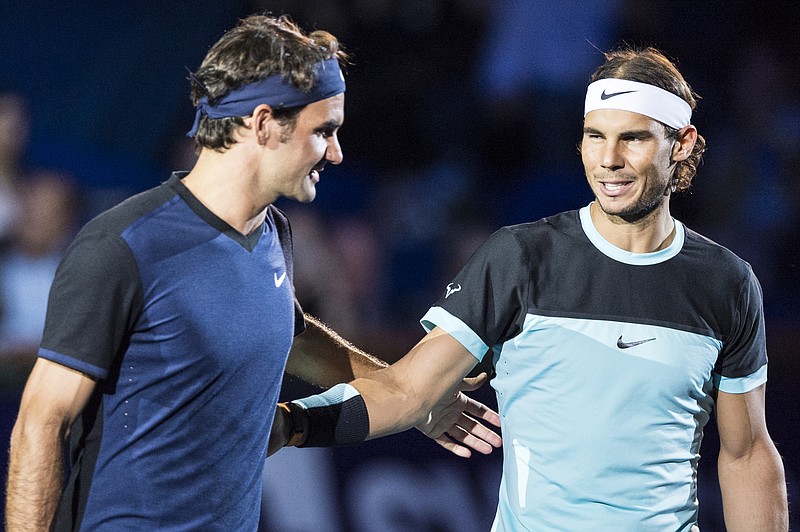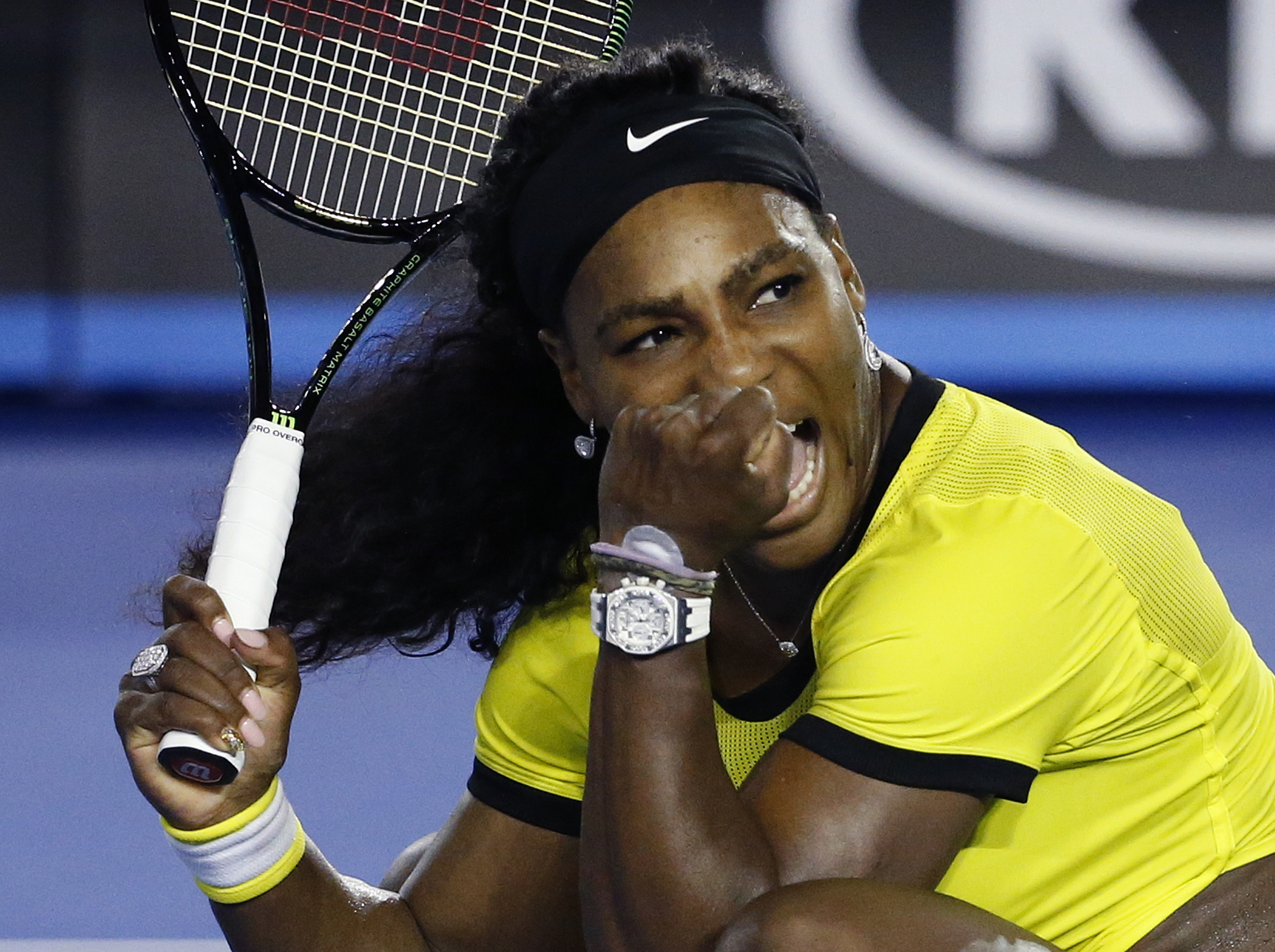I'm old enough to remember Billie Jean King's tennis victory over the carnival barker Bobby Riggs in the 1973 "Battle of the Sexes" spectacle. And that's what it was inside Houston's Astrodome that Sept. 20 evening - a spectacle that drew the largest tennis crowd in U.S. history (30,492) to watch the 29-year-old King sweep three sets from the 55-year-old Riggs and cart home a winner-takes-all $100,000 payday.
Nearly 43 years later it's easy to argue for either side in the match. King, one of the finest players in the history of the women's game, was 26 years Riggs' junior. She should have won. On the other hand, the pressure on her to secure that win was almost unfathomable for the future of the women's professional game.
Or as she said years later, "I thought it would set us back 50 years if I didn't win that match. It would ruin the women's tour and affect all women's self-esteem."
 FILE - In this Jan. 29, 2016 file photo, tennis legend Billie Jean King, left, laughs, reacting to President Barack Obama's remarks at a gathering in the Eisenhower Executive Office Building on the White House complex in Washington. King was the keynote speaker Wednesday, Feb. 10, 2016 at an annual luncheon honoring the birthday of suffragist Susan B. Anthony, who was born on Feb. 15, 1820. King said during her speech that Anthony’s life continues to inspire those fighting for equality, and she urged attendees to “keep making history.” (AP Photo/Manuel Balce Ceneta)
FILE - In this Jan. 29, 2016 file photo, tennis legend Billie Jean King, left, laughs, reacting to President Barack Obama's remarks at a gathering in the Eisenhower Executive Office Building on the White House complex in Washington. King was the keynote speaker Wednesday, Feb. 10, 2016 at an annual luncheon honoring the birthday of suffragist Susan B. Anthony, who was born on Feb. 15, 1820. King said during her speech that Anthony’s life continues to inspire those fighting for equality, and she urged attendees to “keep making history.” (AP Photo/Manuel Balce Ceneta) To make it worse, she actually trailed 4-2 in the opening set to Riggs before rallying to win 6-4, 6-3. 6-3. Given that Riggs had toppled world No. 1 Margaret Court only months earlier in straight sets in what came to be known as the "Mother's Day Massacre," imagine what must have been running through King's head when she fell into that 4-2 hole.
But she won, women's tennis soared, and because of that we've spent the last 43 years treated to such incredible and storied women's rivalries as Chris Evert versus Martina Navratilova, Steffi Graf versus Monica Seles and the rest of the sport versus the incomparable Serena Williams.
Yet the caveman notion that all these bright, talented, dedicated women are somehow inferior to their male counterparts in their ability to produce provocative, entertaining, competitive tennis once more took center stage this past weekend at the BNP Paribas Open.
That's when then-tournament director Raymond Moore strangely decided to observe:
"In my next life, when I come back, I want to be someone in the (Women's Tennis Association), because they ride on the coattails of the men. If I was a lady player, I'd go down every night on my knees and thank God that Roger Federer and Rafa Nadal were born, because they have carried this sport."
No one apparently solicited Moore's feelings on this subject. And his widely panned beliefs led to his resignation as tournament director less than 36 hours later. But it once again ignited a firestorm among men and women professional tennis players regarding their perceived earning powers.
Nor did the chief spokesman for the men's view, world No. 1 Novak Djokovic, exactly calm the furor when he noted that equal pay arguments should be considered again, "because the stats are showing that we have much more spectators on the men's tennis matches."
He also delivered a sort of left-handed compliment to the women by praising their ability to overcome biological issues, saying, "You know, the hormones and different stuff - we don't need to go into details."
The devil is always in the details and the details regarding the financial differences on the men's and women's tours aren't necessarily as one-sided as men's tour (ATP) members might believe.
For instance, at the biggest tournaments - such as the BNP Paribas Open at Indian Wells Tennis Garden in California - both the men's winner (Djokovic) and women's champ (Victoria Azarenka) received the same prize money of $1.03 million, which is customary in the elite events such as Indian Wells, Miami and Cincinnati and guaranteed in the four majors since 2007.
Not that the men don't have their statistics to back their arguments for higher pay. According to a BBC article earlier this week, 395 million watched WTA Premier events and finals on TV and digital in 2015, compared with 973 million for ATP events. Those figures don't include Grand Slam viewership.
More ammo for the men: The 2015 Wimbledon men's final attracted a peak audience of 9.2 million viewers, compared with 4.3 million for the women's final. The U.S. Open similarly favored the men, the final drawing 3.3 million viewers compared to 1.6 million for the women.
But the women also have their arguments. Though this past September's U.S. Open men's final more than doubled the women's final, the women's TV ratings were higher in that event in both 2014 and 2013. The women also sold out their 2015 U.S. Open final more quickly than the men in anticipation that Serena Williams would be going for a calendar Grand Slam, though she ultimately lost in the semis.
So there are clearly arguments both ways, including the fact that the men play best-of-five sets in Grand Slam events compared to best-of-three for the women.
But to return to the now unemployed Moore's comments about Federer and Nadal, the other men's player should also bow down every day and thank God that Federer and Nadal were born because whatever success pro tennis has these days - and on the men's side it pales in comparison to golf - it's as popular as it is largely because Federer and Nadal have been to tennis the past decade what Arnold Palmer and Jack Nicklaus were to golf in the 1960s.
After that, it's almost all a matter of taste. The men clearly have more speed and power. But much like women's basketball at the collegiate level, women's pro tennis appears much more diverse in terms of varying styles and strategies. Furthermore, while the women play best-of-three sets, their games tend to last longer. Court time, if that's your argument, is not as different as one might think.
Either way, it seems clear that the WTA is not just getting older but better by the year.
Unfortunately for all of tennis, as their combined lack of a single major title over the past 20 months suggests, Federer (34) and Nadal (29) are only getting older.
Contact Mark Wiedmer at mwiedmer@timesfreepress.com.

